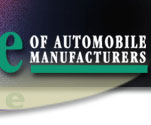
 |
 |
 |
| Introduction The automobiles of today originated from humble beginnings more than 100 years ago. Dubbed the “horseless carriage,” automobiles from the 19th century have evolved into today’s high technology marvels. Technologies from the computer, aerospace, and military industries are among those making automobiles safer, more reliable, cleaner, and more fuel-efficient. Fuel injection technology led to the replacement of carburetors, making engines more powerful and more fuel-efficient at the same time. Computer chips in today’s vehicles manage multiple functions — from regulating fuel to reducing emissions. Indeed, the computer systems in today’s automobiles and light-duty trucks are more powerful than those used during the Apollo moon mission. Manufacturers have years of experience in researching, designing, and developing gasoline-fueled vehicles and considerable efforts and resources will continue to focus on improving these vehicles. Over the next three years, manufacturers will be introducing clean gasoline technologies — vehicles that meet California’s strict Super Ultra Low Emission Vehicle (SULEV) and Partial Zero Emission Vehicle (PZEV) emission standards — with improved fuel economy. Improved gasoline vehicle technology allows manufacturers to meet or exceed regulatory requirements in a cost-effective manner while continuing to produce vehicles that are readily acceptable to consumers. Member companies of the Alliance of Automobile Manufacturers have invested billions of dollars in research and development. These companies are working to bring cutting-edge technologies — alternative fuels, hybrid electric, electric, and fuel cell vehicles — to the marketplace. The challenges to bringing the cars of the future to consumers are significant. The cost of advanced technology vehicles is considerably higher than the same vehicle powered by conventional combustion engines. And consumers want technologies they understand and that provide the comfort, safety, and convenience to which they’ve grown accustomed. Further, these advanced technologies may require specialized charging and refueling infrastructures not yet in place, and in some cases ultra-clean, sulfur-free fuel that is not readily or widely available. Equally challenging for automakers are the competing demands of regulating authorities. Some of the most promising technologies for increasing fuel economy, such as clean diesel, may be restricted from the marketplace because of the strict emission standards imposed on automobiles and light-duty trucks in the United States. Implementing technologies that provide the environmental and safety benefits required by regulators and that provide the utility and convenience consumers demand, all at an affordable cost, are just some of the hurdles automakers face. Still, the advanced technology vehicles that are reaching the marketplace or are under development offer great promise for the future. The Alliance of Automobile Manufacturers’ Advanced Technology Primer provides a preview of some of these vehicles, and similar information is located on the Alliance web site at http://www.autoalliance.org/.
COPYRIGHT © 2003, THE ALLIANCE OF AUTOMOBILE MANUFACTURERS, ALL RIGHTS RESERVED USAGE SUBJECT TO RESTRICTIONS – SEE OUR TERMS OF USE |